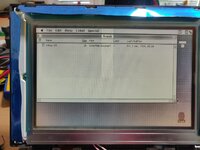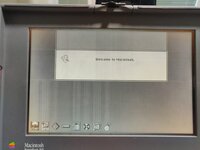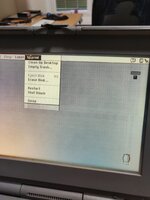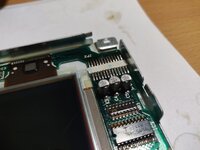I touched on this in a previous thread (https://68kmla.org/bb/index.php?threads/odd-bodge-wire-on-powerbook-160.40023/) but it would likely have been lost by the misleading topic.
I have a working PowerBook 160, but the screen is not behaving. When I first got it - no matter what, I got absolutely nothing showing on the display. I recapped the display and saw an improvement - I could at least now see something on screen when the display was set against a piece of paper, but the minute I re-assembled, unless I throw the let hand control (contrast?) all the way to the bottom, I can't make anything out.
After another suggestion I recapped the inverter board. Despite what looked like some possible gunk they tested okay enough on the ESR, so it's no surprise that I didn't see any major improvement.

My phone camera doesn't seem to capture it very well as I think it's auto-compensating for the white balance and making it look like it has more contrast than it does, but this is a fairly good idea of what I'm dealing with.
My first thought is that I'm assuming contrast is controlled by an an analogue voltage signal - does anyone know what pin that is on, and what the voltage range should be? That seems like a good thing to check.
I have a working PowerBook 160, but the screen is not behaving. When I first got it - no matter what, I got absolutely nothing showing on the display. I recapped the display and saw an improvement - I could at least now see something on screen when the display was set against a piece of paper, but the minute I re-assembled, unless I throw the let hand control (contrast?) all the way to the bottom, I can't make anything out.
After another suggestion I recapped the inverter board. Despite what looked like some possible gunk they tested okay enough on the ESR, so it's no surprise that I didn't see any major improvement.

My phone camera doesn't seem to capture it very well as I think it's auto-compensating for the white balance and making it look like it has more contrast than it does, but this is a fairly good idea of what I'm dealing with.
My first thought is that I'm assuming contrast is controlled by an an analogue voltage signal - does anyone know what pin that is on, and what the voltage range should be? That seems like a good thing to check.








